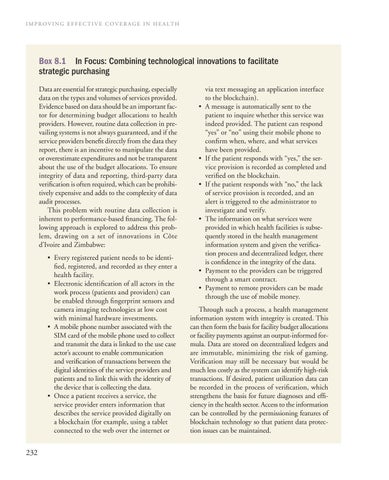IMPROVING EFFECTIVE COVERAGE IN HEALTH
Box 8.1 In Focus: Combining technological innovations to facilitate strategic purchasing Data are essential for strategic purchasing, especially data on the types and volumes of services provided. Evidence based on data should be an important factor for determining budget allocations to health providers. However, routine data collection in prevailing systems is not always guaranteed, and if the service providers benefit directly from the data they report, there is an incentive to manipulate the data or overestimate expenditures and not be transparent about the use of the budget allocations. To ensure integrity of data and reporting, third-party data verification is often required, which can be prohibitively expensive and adds to the complexity of data audit processes. This problem with routine data collection is inherent to performance-based financing. The following approach is explored to address this problem, drawing on a set of innovations in Côte d’Ivoire and Zimbabwe: • Every registered patient needs to be identified, registered, and recorded as they enter a health facility. • Electronic identification of all actors in the work process (patients and providers) can be enabled through fingerprint sensors and camera imaging technologies at low cost with minimal hardware investments. • A mobile phone number associated with the SIM card of the mobile phone used to collect and transmit the data is linked to the use case actor’s account to enable communication and verification of transactions between the digital identities of the service providers and patients and to link this with the identity of the device that is collecting the data. • Once a patient receives a service, the service provider enters information that describes the service provided digitally on a blockchain (for example, using a tablet connected to the web over the internet or
232
•
• •
•
• •
via text messaging an application interface to the blockchain). A message is automatically sent to the patient to inquire whether this service was indeed provided. The patient can respond “yes” or “no” using their mobile phone to confirm when, where, and what services have been provided. If the patient responds with “yes,” the service provision is recorded as completed and verified on the blockchain. If the patient responds with “no,” the lack of service provision is recorded, and an alert is triggered to the administrator to investigate and verify. The information on what services were provided in which health facilities is subsequently stored in the health management information system and given the verification process and decentralized ledger, there is confidence in the integrity of the data. Payment to the providers can be triggered through a smart contract. Payment to remote providers can be made through the use of mobile money.
Through such a process, a health management information system with integrity is created. This can then form the basis for facility budget allocations or facility payments against an output-informed formula. Data are stored on decentralized ledgers and are immutable, minimizing the risk of gaming. Verification may still be necessary but would be much less costly as the system can identify high-risk transactions. If desired, patient utilization data can be recorded in the process of verification, which strengthens the basis for future diagnoses and efficiency in the health sector. Access to the information can be controlled by the permissioning features of blockchain technology so that patient data protection issues can be maintained.

